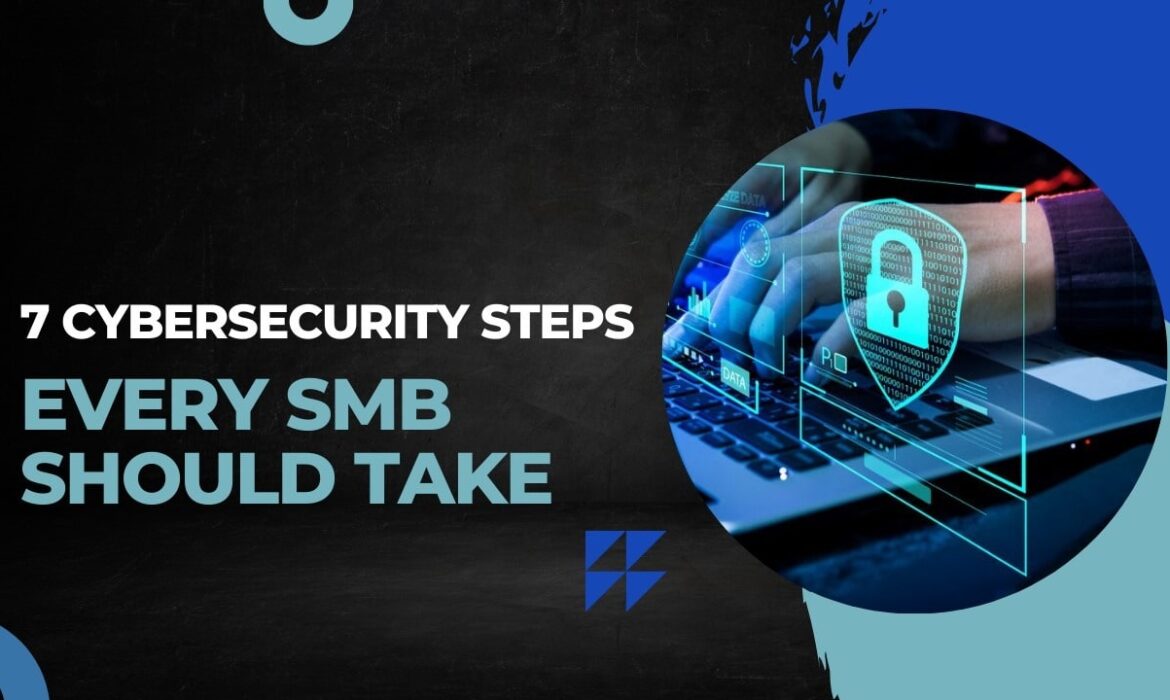7 Cybersecurity Steps Every SMB Should Take
Cybersecurity Steps : In an era where technology is an industry core, cybersecurity has become a major concern for businesses of all sizes. Small to medium-sized businesses (SMBs) are no different, as they often lack the many resources and dedicated cybersecurity teams that larger businesses have but neglecting cybersecurity can have significant consequences for SMBs, from data breaches to financial loss to anonymity. To protect their digital assets from damage and maintain the trust of their customers, SMBs must prioritize cybersecurity. In this blog post, we’ll cover seven essential cybersecurity steps that every SMB should take to ensure they’re strongly protected against cyber threats.
Conduct a Risk Assessment
Understanding the specific risks your business faces is the first key to creating an effective cybersecurity strategy. Perform a comprehensive risk assessment to identify potential vulnerabilities and hazards. This includes analyzing your network infrastructure, software configuration, and administrative practices. Consider contacting a cybersecurity professional or using tools to help identify potential vulnerabilities. By thoroughly analyzing your risks, you can tailor your cybersecurity measures to address the specific challenges your SMB faces.
Implement a Robust Firewall
A firewall acts as a digital barrier between your internal network and external threats. SMBs should invest in robust firewall solutions to monitor and manage incoming and outgoing network traffic. This critical cybersecurity program helps prevent unauthorized access, malware attacks, and other cyber threats. Additionally, ensure that the firewall is configured so that its rules and policies are regularly updated to keep pace with evolving cyber threats. Check and maintain your firewall system regularly for optimal protection.
Also Read: What is an email secure server and what are its advantages?
Educate and Train Employees
Cybersecurity Steps : Human error remains one of the most significant contributors to cybersecurity incidents. Equip your employees with the knowledge and skills needed to recognize and avoid potential threats. Conduct regular cybersecurity training sessions to educate them on best practices, such as identifying phishing emails, using strong passwords, and securing sensitive information. Encourage a culture of vigilance and empower employees to report any suspicious activity promptly. Remember, your employees are your first line of defense, and their awareness is critical in maintaining a secure digital environment.
Regularly Update Software and Systems
Outdated software and systems are a common entry point for cyber attackers. Ensure all software applications, operating systems, and security patches are up to date. Make sure there are updates regularly and implement a system to accelerate implementation. Many cyber threats exploit vulnerabilities in older software, making this an important step in reducing the risk of a successful attack. Productivity tools can help monitor and maintain innovation, ensuring that your SMB stays protected against the latest threats.
Also Read: A Comprehensive Guide to Finding the Best Certified Certified in Cybersecurity UAE
Secure Wi-Fi Networks
Unsecured Wi-Fi networks pose a serious threat to SMBs, as they can be used by cybercriminals to gain unauthorized access to sensitive information Use strong encryption protocols such as WPA3 on your Wi-Fi. Exit networks to protect them from unauthorized access. Additionally, change default passwords on router access points to prevent easy exploitation by attackers. Consider creating a separate guest interface to separate your access from visitor-critical business processes. Regularly monitor and inspect your Wi-Fi network to find and address any potential vulnerabilities.
Back Up Data Regularly
For SMBs, data loss can have serious consequences, from business disruption to reputational damage. Implement a regular data backup program to ensure that sensitive information is protected and recoverable in the event of a computer disaster. Choose a reliable backup solution that backs up data on schedule. Keep backups in a secure, off-site location to avoid losing your physical work at your primary place of business. Test the recovery process regularly to ensure that your backup solution is working properly and can recover your data quickly.
Collaborate with Cybersecurity Experts
For low-security SMBs, partnering with cybersecurity experts can provide valuable assistance in building and maintaining a strong cybersecurity posture Consider using a cybersecurity service that will provide specialists with advanced skills and equipment that may be beyond the capacity of the facility. This can include services such as penetration testing, threat intelligence, and 24/7 monitoring. By working with cybersecurity professionals, SMBs can benefit from the latest industry knowledge and stay ahead of emerging cyber threats.
Conclusion
In conclusion, cybersecurity is not a one-time effort but an ongoing commitment that requires attention and investment. SMBs must recognize the importance of securing their digital assets to protect both their business and their customers. By following these seven cybersecurity steps, SMBs can significantly enhance their defenses against the ever-evolving landscape of cyber threats. From risk assessments to employee training and advanced collaboration with cybersecurity experts, each step plays a crucial role in creating a comprehensive cybersecurity strategy tailored to the unique needs of small and medium-sized businesses. As the digital landscape continues to evolve, prioritizing cybersecurity is not just a necessity; it’s a strategic imperative for the sustained success of SMBs in today’s interconnected world. If you are looking for the best cybersecurity companies in UAE, contact us at Green Edge Computers.



